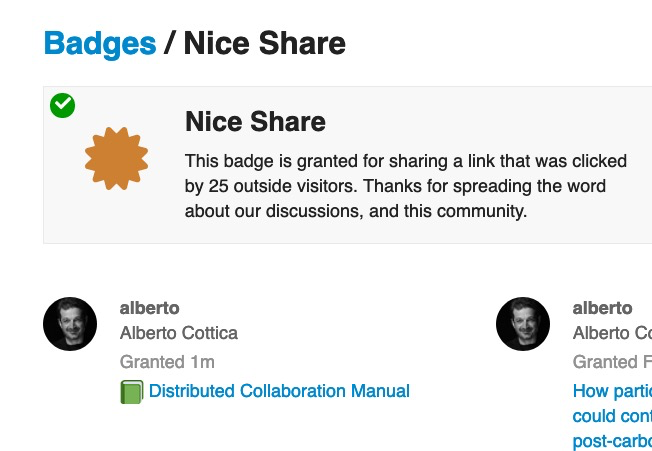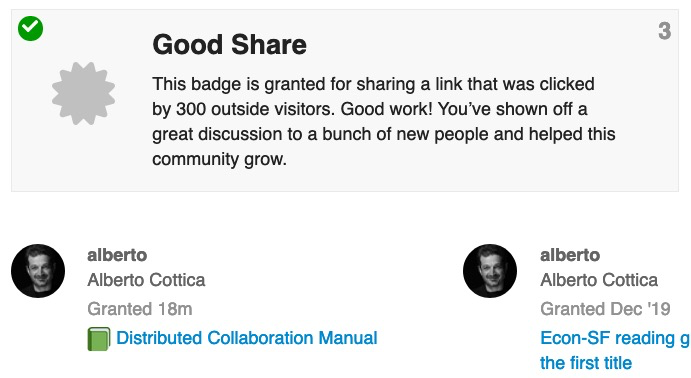Here I would like to add that when having written communication we should also be aware that it is estimated that between 5-10% of the population has dyslexia, but this number can also be as high as 17% and in certain professions, such as design for example can be even higher (My University paid for students tests and measured up to 30% in some courses). With this knowledge we should also stress that misspelled words are not to be understood as a lack of caring or lazyness of not using a correction tool. For people with some form of dyslexia it could be very time-consuming or even impossible to make sure to get all words right.
If I can comment on this from my experience:
I used to have a pretty rigid and fairly simple structure.
Main goal oriented activity categories (e.g. presentations, scientific publications, research results) and main organizational / ongoing operations things (usually under: orga, or things like literature research)
Within goal oriented folders I would differentiate by project (e.g. collaboration partner, or funding source) and in some cases by type of work (e.g. microscopy).
Below that I would have only the main folders: prep and final. If I had to collaborate a lot (by sending stuff around in mails) I would also track incoming and outgoing versions in respective folders.
That said, I have worked with people who do a lot of design / editing work, and they generally depend much more on control of their folder structure, often 10 levels or more deep, and can’t be asked to compromise.
Similarly with the advent of cloud based work I have fully transitioned to a pile-and-search approach, which is much more shareable, but also profit from some degree of coordination on the naming schemes.
In my opinion working with someone else’s (or rigid) folder structure will invite more trouble through non-compliance. It is not a hill I would want to die on with work becoming rather more than less organic.
Naming (or tagging) better is more what I’d lean to.
That’s nice because I have arrived at the very same structure, with slightly different names for the same concepts. Nice mutual confirmation that the basic distinction between project folders and data store folders is relevant and meaningful.
My system goes like this: All my goal oriented activities are in ~/Projects/ and ~/Projects.Closed/ for finished ones. All my other data is sorted into main folders by data type. That other data can be non-project data, cross-project data, and also project data whenever there is a reason why putting it into a cross-project, database-like folder is better than the default of placing it into the project’s folder.
So taken together, my home directory looks like this:
Contacts
E-Mails
Geodata
Literature
Manuals
Media.Audio
Media.Movies
Media.Music
Media.Photos
Media.Videos
Mindmaps
Money
People
Projects
Projects.Closed
Settings
Software
StateProcesses
Telecommunication
Templates
Things
TimeTracking
For team collaboration on files, honestly, I am still not convinced that this is the way to go. You can only search for what you know exists. And you cannot search for content of videos or audio files (given current technology). So at some point, you can either browse messy folders, or ask a colleague who knows what they put where (which is exactly what a collaboration tools should avoid).
Ha - this could almost be my “non-work” folder exactly.
Only thing is that I have a Media.text folder for copy / backup convenience as well (usually the most expensive content per bit).
I am still not convinced
Yeah the pile-and-search thing is because I had to work with the google suite. And without plug-ins their (web interface) folder system is such a farce that I can only explain it by them having taken a strategic decision to deprecate folders as soon as they can. And my opportunistic (career guided) self wants to be ready for that moment to have a competitive advantage.
That is an interesting point I would like to contend. What I do once in a while is just sort everything by “last modified” and go down that list for a few dozen entries.
That is in my opinion an extremely fast way to get an idea of where everyone’s head is at currently (provided all is visible and shared).
That’s a nice trick, I’ll edit it into the manual somewhere 
(Also it means “one big folder for everything” in a project. Wow, I had not imagined that anyone would take pile-and-search to such an extreme.)
Not project, company. Yeah people have all kinds of folders but when the “official” folder names repeat in their respective sub-folders you know - if you get into those trenches you’ll be there a looong time. Just move on.
Ok I understand it will work better than infinitely recursive subfolders and what-have-you. So it would qualify as a best practice for the extreme cases … I mean, different cases, different treatments …
Move fast and break things.
Folder structures will be in the first 10% of casualties - unless you have a very specific kind of CEO.
Sam, could you explain this, please? I don’t get it.
Oh, this is mind-blowingly good, and useful! I will digest it as soon as possible and most likely pass it on in my day job.
I’ve been working close to this domain recently, trying to capture my common sense in distributed collaboration, coaching colleagues who can’t seem to play nicely with Office 365 nor a wiki.
Of course I have a couple of items I hope to contribute as well. Oh and while I’m writing (I’m here infrequently at the moment) I saw an edit comment from @hugi indicating he may like to use one of my posts in some blog - to which I say, go ahead! Attribution is appreciated, beware that the Minecraft info is dated (though may still be fairly accurate). Revise language and content as you see fit. Lots of love ![]() /CJ
/CJ
Thank you for the positive feedback, much appreciated!!
Of course I’m curious about your own experiences and common sense knowledge about this topic. (Welcome to just dump it here in comments, I’ll do the service to everyone with little time on their hands and integrate it into the wiki. Of course, also welcome to edit the wiki directly.)
Unrelated side note: I am tempted to rename this document temporarily to “The ultimate weapon to beat coronavirus at your workplace” or something similar  It certainly does not get the attention it deserves right now, where the document only argues for remote collaboration as climate protection …
It certainly does not get the attention it deserves right now, where the document only argues for remote collaboration as climate protection …
While I care more about memetic epidemiology, knock yourself out ![]()
Pasting my current list of principles below. Beside these I have also pondered the various qualities of communication / information - it is difficult, but not homogenously so in for instance how what needs to be kept up to date need not necessarily be very detailed, and vice versa. The “as if continuously publishing for someone” below touch on a thought yet to be formulated, about calls to action and cherishing attention, similarly to how you make it easy for me suggesting I just contribute, regardless that I have not yet checked whether I have overlaps with what is already written ![]()
Guiding principles / fundamental assumptions
- We operate in an information-rich world, facing that successfully is key (see Fred Brooks, Herbert A. Simon, Melvin Conway)
- Set standards, learn the methods to sustain them. Sophisticated solutions codified in accessible culture
- Most problems are solved in some places, scale solutions and learn from what works
- Invest in sharpening your most frequently used tools
- Disorder accumulates, accept and continuously work to mitigate it. Reduce complexity, avoid incidentally increasing it. Manage groups of people and things rather than individuals, automate and generalize
- Information exists in networks, both tangible and abstract such. Links are what define network structures and thus significantly affect characteristics – if the network is useful or not. Use ubiquitous linking (only adhering to common sense) to manage information
- Consider other reasonable information practices (e.g. “upstream first”, originator, authority, audience, attention capacity / efficiency, review, transience / permanence, development / in the moment / maintenance, relations (links), location, medium / tools, overview, collaboration, cognitive funneling). Even that little extra effort goes a long way
- Some accurate information now is better than all inaccurate information until later. Work with transparence, as if continuously publishing for someone
- Be bold but strive to respect policies and collaborators
- You are one person in a great team
Edit 2021-08-30: Gentle revision - this is largely originating from my old presentation Staying afloat or aiming for the stars - maintaining and improving your development environment for Ericsson Software Craftsmanship Community
If you share it with the right hashtag on social media…

And indeed…

@matthias It is mentioned elsewhere how links may clutter documents - and I’m not sure if I inspired you here or not, but how do you feel about appending a link here to “CJs ‘Meditation on group communication’” for further thoughts on the topic?
Anyway, it’s a segment I care about, and would love to embed also the aforism “don’t confuse motion for progress”. Mostly I’m just mentioning it as a heads up before I go about and edit ![]()
As much as I appreciate climbing the complexity hierarchy - this statement came off to me as too weird, too soon. The continuation of the reasoning is great, but why am I to believe the blanket statement as if a prime principle of monks and nuns of all religions live to “provide an enjoyable environment for each other”. Doesn’t strike me as particularly ascetic for instance. Perhaps we can embed some examples?
You wrote that Monday 2/3… Yesterday or the day before that our workplace moved to recommend that anyone who could should work from home, VPN is being heavily loaded and, on a positive note, there’s more attention than ever for efforts to mitigate the impact of being forced into distributed collaboration. Assuming the world keeps standing, surely surviving organizations will be much stronger in this aspect.
Do we have view statistics for this page?
I believe discord and zoom now support this in the settings. For discord I think it was only in the standalone app, not running in the browser.
For me this has already lead to the next issue though:
I connect a bluetooth RX/TX dongle with mic so I can run around while listening, but as these dongles usually lack the PTT-button, I have to sprint back to the keyboard when I have to say something. Obviously only relevant for semi-important or less calls.
I wonder when the first generation will start to find meetings via video or VR chat or whatever more effective and natural than meeting in person?
I already feel like writing by hand is extremely ineffective and weird to me, but I am sure there were many and are still some who said that only by writing per hand can you properly think things through and connect to them.
It is a matter of what your grow up with and accustomed to.
Once tools for synchronous and asynchronous online collaboration are more developed accepted.mastered come the point when their effectiveness also in visualising and communication something will outpace the group sitting together with the whiteboard.
Or maybe calls vs. texts and emails are a good example. Having a “real call” is an exeption, just calling someone without asking beforehand even more. Texts and emails have become a norm for more effective communication and already feel “more natural” then “just calling someone to ask something”.
